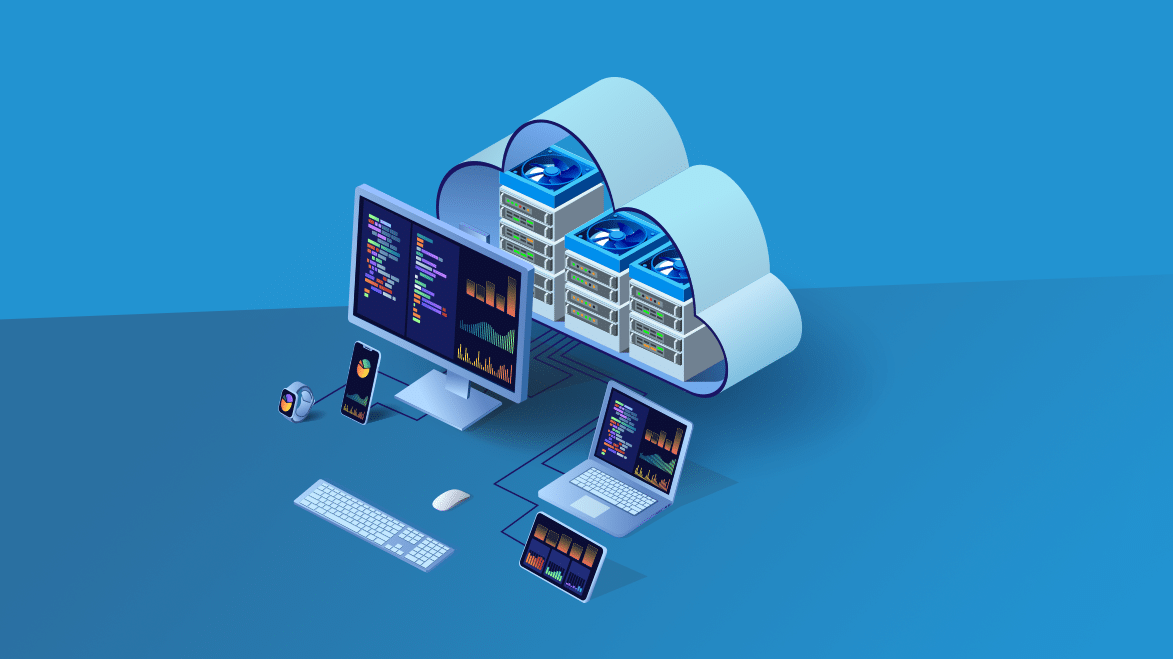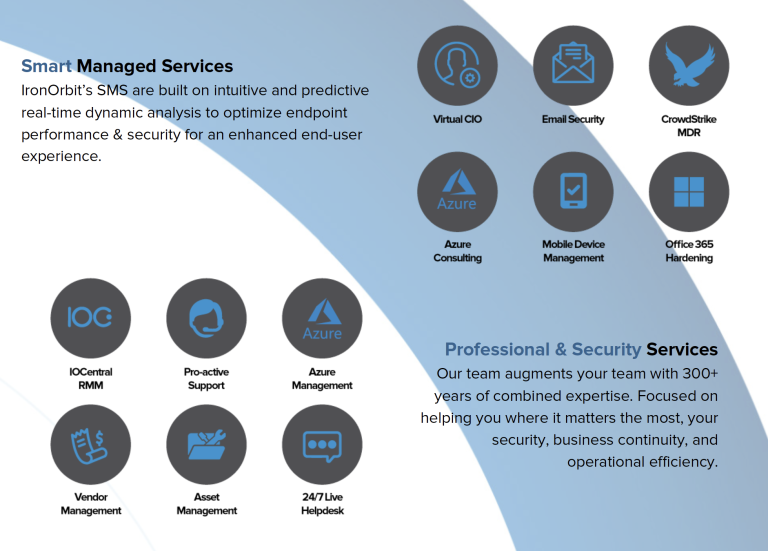The Six Key Benefits of Using DaaS (Desktop as a Service)
Back when most of the IT experts of today began in the industry, the only infrastructure that was readily available and dependable was on-site servers and networks that were bulky, expensive, and time-consuming to manage and maintain. The last ten years have witnessed tremendous advancements in information technology. Now, IT engineers can design, develop, and implement a company’s entire IT infrastructure within a cloud environment in a fraction of the time it used to take. This good news isn’t just for the IT experts, but for the everyday business owners as well!
Because cloud infrastructure is readily available, you can take advantage of high-powered cloud computing through Desktop-as-a-Service (DaaS). Although DaaS may sound complicated, it’s not. You can use any internet-connected device to access your operating system, applications, business data, and even your desktop settings.
What does that mean for your business? It means anywhere, anytime secure access to your company’s workflow. But that’s just the beginning of the high-impact benefits for forward-leaning companies that choose to leverage the power of Desktop as a Service.
1
Eliminates Grunt Work
Using a DaaS saves your IT department from having to do mundane grunt work such as application licensing, patching, and troubleshooting.
Outside of the fact that DaaS lowers your IT management cost by shifting that responsibility to the cloud provider is the fact that your organization has to spend less effort on maintaining your IT assets. Even companies that have outsourced their IT maintenance to a 3rd party still have a measure of IT housekeeping that they must do internally. DaaS makes IT maintenance and management hands-free for your staff – allowing them to be more effective and efficient in the tasks they were hired to do.
If you’re tired of employees complaining about their computers – or about the IT support – if you’re sick of doing endless updates, upgrades, patches – all to avoid the blue screen of death – DaaS is where you want to be. Most cloud providers offering DaaS have proven their ability to maintain their promise of 99.99% reliable uptime. That’s good news for your workflow and for your ability to focus on your work – not IT issues.
2
Data Redundancy
DaaS puts your company’s workflow in your hands instead of at the mercy of IT roadblocks, ransomware, or a natural disaster like hurricanes, fires, and tornados.
You don’t have to worry about a local network crashing – because there is none. It’s all in the cloud. You don’t have to think about losing data if your laptop dies – because your actual “computer” is virtual and all your data is stored in the cloud. Instead of having an operational IT system and a Business Continuity strategy backup system, you’re using your Business Continuity system every day in the cloud.
Since your data is stored at a secure facility offsite; or, in the case of IronOrbit, stored at multiple data centers, it is protected against onsite server failure or natural disasters. Having redundant backups provides a safety net. If a natural disaster impacts data center one, data center two kicks in automatically.
3
Increased Security
IT support teams in businesses take reasonable precautions to guard against cybercrime. These security measures cannot compete with the security technologies employed by cloud providers delivering DaaS options for businesses.
Critically DaaS shifts the security burden away from the individual device and places it within a data center infrastructure designed for the highest levels of protection. To put it simply, it would be cost-prohibitive for a small to mid-size business to hire even one IT security professional to protect their in-house systems to the level of a Tiered private cloud hosting partner.
Data is no longer vulnerable on a local device but held – and regularly backed up – in a secure hosted environment; it is also encrypted and can be made accessible only through multi-factor authentication protocols. The addition of a designated managed service provider also has its advantages. Systems are monitored 24/7. For example, a managed service provider can prevent someone from stealing data using a USB. That’s why enterprise-class organizations, the military, and the government are overwhelmingly looking to cloud providers to host their workflow. The security is there.

4
Enhanced Flexibility, Agility, & Mobility
We’ve already noted that cloud infrastructure along with new virtual desktops for your staff can be deployed in record time in comparison to traditional on-site IT setups. But that’s just a baseline. Consider the fluctuations of the marketplace over the past few years. The companies that survived and thrived were the ones most able to, in the words of Mohammad Ali, “Float like a butterfly and sting like a bee.” Companies need a high level of agility combined with decisive leadership that can act quickly. DaaS allows you to scale up or down easily, add or reduce capacity, and change directions on the fly if needed.
Once you’ve moved your IT system to a DaaS, mobility becomes much easier. Modern companies are flexible enough to have their employees work from anywhere and on any device of their choosing. To thrive in the new cloud ecosystem, companies will need every tool available to be resilient. Teams will have to expand and contract at a moment’s notice, and they will need to respond quickly to opportunities the moment they appear. DaaS is a building block that makes all of that possible.
Being agile and flexible enables organizations to pivot if need be to remain resilient. Mauro F. Guillen writes, in a recent HBR article, that “successful companies often pivot to a business model that’s conducive to short-term survival, and long-term resilience and growth. Pivoting is a lateral move that creates enough value for the customer and the firm to share.”
The focus is now on productivity, elasticity, and value to the customer. These are the main characteristics that will drive the proliferation of DaaS in business.
5
Reduces Upfront Costs
DaaS reduces enormous upfront costs. Imagine all the hardware you’d have to invest in just to get started. In-house IT infrastructure and computers have to be purchased and implemented with the next 3-5 years of business operations in mind. Recent events have shown that it is impossible to predict the next year much less project 3 to 5 years out.
Even during times of stability, it is often a challenge to budget for hardware replacement. CFOs have to also account for the depreciation of capital expenditures. From the moment you open the box on a new computer, the value depreciates. With many companies still in recovery mode, many are having to delay refreshes altogether, even at the risk of struggling with outdated technology.
DaaS provides the luxury of keeping IT aligned with workflows no matter how dynamic and volatile they may become.
Since DaaS is subscription-based, you’re renting equipment. This subscription-based model moves expenditures from a capital expenditure (CapEX) to an operational expenditure (OpEx). You’re only going to pay for what you use; therefore, if you use a lot, you’re going to pay more. Correspondingly, if you don’t use very much, you pay a minimum amount. This is a CFO’s dream come true because it streamlines operations in ways that lower overall operational costs.
CFOs love DaaS and other cloud-based solutions because of the budget predictability provided by packaged solutions but the fact that they can move CAPEX expenses into the OPEX column. This provides a range of financial and tax efficiencies. #1 in those efficiencies is that your company doesn’t have to pay a large amount of money for in-house servers and networks to be installed. And when your business grows, you don’t have to factor bigger, better servers (with bigger and better prices) into your budgets. Moving IT expenditures from CAPEX to OPEX gives you the flexibility to utilize your cash reserves for other, pro-growth initiatives. Having a fixed and predictable monthly fee certainly makes budgetary planning and forecasting much easier than the break and fix nature of on-premise servers or even in-house VPNs.
6
Energy Conservation Helps the Environment
You’re only one company, but you want to do your part for the environment – and you want your consumers to SEE you doing your part for the environment. Because DaaS allows you to use your devices for longer and to partner with eco-conscious cloud platforms, you can do your part for the planet without it costing you more to do so.
A study conducted by the Carbon Disclosure Project found companies that utilized cloud computing saved a total of $1.3 billion annually and reduced carbon emissions by an equivalent of 200 barrels of oil.
Just imagine the hardware and electrical power needs of even a small-size company. An organization saves tremendous amounts of energy by moving its IT system to a DaaS environment because no onsite servers are gobbling up massive amounts of electrical power. More employees working from home means fewer carbon emissions from vehicles traveling to and from work every day. When you start to consider the number of companies and the number of employees involved, the amount of carbon emissions is significant.
As our lives, work, and thinking turn increasingly towards protecting the climate, conserving energy by leveraging shared data centers will become more attractive and competitive. As this move to remote data centers matures, operators will begin to assess “greener” options for on-site power generation. Data centers are an excellent opportunity to integrate on-site energy generation facilities such as hydrogen applications, solar panels, or a combination of heat and power solutions (CHPs).

Marc Garner, VP of Schneider Electric’s Secure Power Division.
Marc Garner, VP of Schneider Electric’s Secure Power Division.The Vice President of Schneider Electric’s Secure Power Division, Marc Garner wrote in Data Center Dynamics, “Technology has become a key enabler for both businesses and consumers alike, and throughout 2020, dependency on digital infrastructure has increased dramatically. In fact by 2035, Schneider Electric estimates that all IT will consume 8.5 percent of global electricity – compared to 5 percent in 2021 – and data centers are expected to take up a large share of this demand. Many of today’s data center operators, from hyperscalers to cloud and colocation service providers, have already led the market by example, and publicly declared ambitious commitments towards Net Zero, adopting more sustainable approaches to digital business.
Microsoft, for example, has started transitioning to using renewable wind energy – a trend that will likely only continue to increase as awareness and demands for renewables from end-users and governments surge.”
Conclusion
Your business is moving into the future, whether your IT systems are ready for it or not. Using virtual desktops in a DaaS environment ensures you’re always working on the latest version of your operating system and applications. That in and of itself is a compelling reason to move to DaaS,
but that’s only the beginning. Consider that DaaS also gives you a built-in business continuity system. Because your data and workflow are securely housed in the cloud, you never have to worry about how much time, money, and lost opportunities you’d sacrifice if your company’s on-site server goes down.
As Gartner describes in a recent report, technologies utilized by organizations are increasingly conceptualized and implemented outside of the traditional outsourced IT department. Gartner found that the total business-led IT spend averaged around 36% of the total formal IT budget. Business leaders rightfully see digital transformation as an organization-wide discussion, and no longer the sole purview of the IT department.
This article categorized 6 key benefits for companies moving to DaaS. Depending on what priorities are driving your organization at the moment, you may be drawn to one specific DaaS advantage or another. Think about both short and long-term goals in your choice. You might consider DaaS to make hardware refresh more affordable in the short term but also reap the cost and business benefits delivered by DaaS as it has a deeper impact on the continued growth and success of your business long term.










